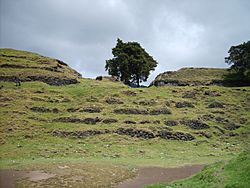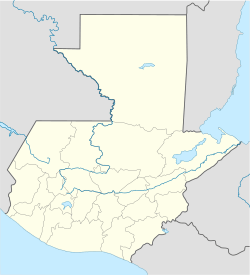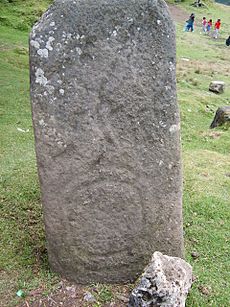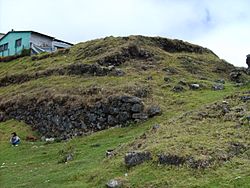Wajxaklajun facts for kids

Ruins of Wajxahlajun
|
|
| Location | San Mateo Ixtatán |
|---|---|
| Region | Huehuetenango Department, Guatemala |
| Coordinates | 15°49′43.43″N 91°28′26.23″W / 15.8287306°N 91.4739528°W |
| History | |
| Abandoned | 16th century |
| Periods | Classic to Postclassic |
| Cultures | Maya civilization |
| Events | Conquered by: Spanish Empire |
Imagine stepping back in time to an ancient city built by the amazing Maya civilization! That's what you'll find at Wajxaklajun. This important ancient ruin is right next to the modern town of San Mateo Ixtatán in Guatemala.
Wajxaklajun was a big city during the Classic period, from about 250 to 900 AD. The Chuj Maya people who live there today believe their ancestors built this city. Wajxaklajun is special because it has many tall stone monuments called stelae. These were usually found in Maya cities in the lowlands, which might mean Wajxaklajun traded or connected with those distant cities.
Contents
What's in a Name? Understanding Wajxaklajun's Meanings
The name Wajxaklajun means "eighteen" in the Chuj language. Some people think this name came from the site originally having eighteen mounds or hills. However, it might also be a name from the ancient Maya calendar.
A longer name for the site was Chonjab' Tepan Wajxaklajun, which means "town and temple eighteen." The site also had other names like Yolk'u, meaning "in the sun," and El Calvario. When the Spanish arrived, they called it Ystapalapán, meaning "place of salt."
Where is Wajxaklajun Located?
Wajxaklajun sits on a ridge in the Cuchumatanes mountains. It's about 2,540 meters (8,333 feet) above sea level. You can find it just east of the town of San Mateo Ixtatán in Guatemala.
This ancient city is about 40 kilometers (25 miles) east of another Classic-period Maya site called Quen Santo. It's also about 60 kilometers (37 miles) from Chinkultic.
How Wajxaklajun Connected with Other Groups
Wajxaklajun likely traded with other groups in the highlands of Chiapas, Mexico. It probably also had indirect trade with the Maya lowlands. The Chuj people living here are thought to have traded salt from their local springs. They would exchange it with the Tojolabal Maya for things like cacao (which is used to make chocolate!). Local stories say the Chuj won the salt springs from the Tojolabal in a battle.
Exploring the Ancient City of Wajxaklajun
The main part of Wajxaklajun stretches along a ridge. The city is built on three different levels. These levels include the natural ground of the ridge, a higher area to the northeast, and a lower area to the southwest. The ancient Maya builders used these natural features when they planned their city.
Many buildings are located on the higher parts of the ridge, offering views of the nearby salt springs. The lower part of the site has a large structure that was probably a pyramid.
It's quite special that Wajxaklajun has so many stelae (tall stone monuments). Stelae were not common in the highlands after a certain period. Their presence here might show that Wajxaklajun had strong connections with Maya cities in the lowlands, where stelae were very important.
Early explorers noticed that Wajxaklajun looked similar to other nearby sites. These included Tenam Puente and Chinkultic in Chiapas, and Zaculeu, the capital of the Mam Maya.
Level 1: The Highest Point
This is the highest part of the ancient city. Part of this level is natural rock, while other sides were shaped into steps or terraces. It's thought that people used a stairway to get from Level 2 up to Level 1, but this stairway has worn away over time.
- Mound E is on a terrace between Level 1 and Level 2.
- Mound G is at the very northern end of the site. When it was first explored, it was covered in plants and had two wooden crosses on it.
- Building 10 is on a flat, man-made terrace. Its walls were once almost 3 meters (10 feet) high and over 1 meter (3 feet) thick. It might have been an early colonial building, like a church or town hall.
Level 2: Central Area
This level is just southeast of Level 1. It has a foundation terrace that supports Mounds A and E. There are also steps leading down to Plaza III. Five plain stelae are found on a narrow part of this terrace.
- Plaza I is a small dip in the terrace.
- Plaza II is southeast of Mound A.
- Plaza III is northeast of Mound A and was likely the main way to approach it.
- Mound A is the biggest feature on this level. It's about 10 meters (33 feet) high and 45 meters (148 feet) long.
- Mound B and Mound C are small structures that look out over Level 3.
- Mound D is a small, damaged mound in the middle of Plaza II. It has a modern wooden cross on it.
Level 3: The Lowest Section
Level 3 is the lowest part of the site. It's mostly the natural ground level of the ridge.
- Mound H is a badly damaged mound southwest of the main structures.
- Mound I was another small, damaged structure in this area.
Threats to Wajxaklajun
The ancient site of Wajxaklajun is in danger because the modern town of San Mateo Ixtatán is growing. New homes are being built right on top of the ruins. There's a high demand for land, which makes it hard for local officials to protect these important ancient remains.
Local Traditions and Importance Today
The local Chuj Maya of San Mateo Ixtatán believe their ancestors built these ruins. They say their ancestors either died when the Spanish arrived or fled to the hills. The Chuj believe their ancestors built these big structures so that future generations would remember them. This idea fits with what archaeologists now understand: that such buildings were often linked to important families and ancestor worship.
Today, the modern Chuj people still see the ruins as a sacred place. It's a spot where they hold traditional ceremonies and festivities. Even Tojolabal people from Chiapas travel to Wajxaklajun to perform their own ceremonies.
See also
 In Spanish: San Mateo Ixtatán (zona arqueológica) para niños
In Spanish: San Mateo Ixtatán (zona arqueológica) para niños
- Kʼatepan






